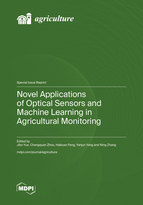Novel Applications of Optical Sensors and Machine Learning in Agricultural Monitoring
A special issue of Agriculture (ISSN 2077-0472). This special issue belongs to the section "Digital Agriculture".
Deadline for manuscript submissions: closed (20 June 2023) | Viewed by 37271
Special Issue Editors
Interests: remote sensing; precision agriculture; machine learning; crop model; crop mapping
Special Issues, Collections and Topics in MDPI journals
Interests: image segmentation; UAV; machine learning; pattern recognition; IOT
Special Issues, Collections and Topics in MDPI journals
Interests: UAV; biomass; nutrient management; yield mapping
Special Issues, Collections and Topics in MDPI journals
Interests: UAV; smart orchard; pest management; pest risk mapping
Special Issues, Collections and Topics in MDPI journals
Interests: remote sensing; climate change; machine learning; ecosystem model
Special Issues, Collections and Topics in MDPI journals
Special Issue Information
Dear Colleagues,
Agricultural production management is facing a new era of intelligence and automation. With developments in sensor technologies, the temporal, spectral, and spatial resolution from ground/air/space platforms have been notably improved. Optical sensors play an essential role in agriculture production management. Especially, monitoring plant health, growth condition, and insect infestation have traditionally been approached by performing extensive fieldwork.
The processing and analysis of huge amounts of data from different sensors still face many challenges. Machine learning can derive and process agricultural information from the optical sensors onboard ground, air, and space platforms. Advances in optical images and machine learning have attracted widespread attention, but we call for more highly flexible solutions for various agriculture study applications.
We believe that sensors, artificial intelligence, and machine learning are not simply scientific experiments, but opportunities to make our agricultural production management more efficient and cost-effective, further contributing to the healthy development of natural-human systems.
This Topic seeks to compile the latest research on optical sensors and machine learning in agricultural monitoring. The following provides a general (but not exhaustive) overview of topics that might be relevant to this Research Topic:
- Machine learning approaches for crop health, growth, and yield monitoring.
- Combined multisource/multi-sensor data to improve the crop parameters mapping.
- Crop-related growth models, artificial intelligence models, algorithms, and precision management.
- Farmland environmental monitoring and management.
- Ground, air, and space platforms application in precision agriculture.
- Development and application of field robotics.
- High-throughput field information survey.
- Phenological monitoring.
Dr. Jibo Yue
Dr. Chengquan Zhou
Dr. Haikuan Feng
Dr. Yanjun Yang
Dr. Ning Zhang
Guest Editors
Manuscript Submission Information
Manuscripts should be submitted online at www.mdpi.com by registering and logging in to this website. Once you are registered, click here to go to the submission form. Manuscripts can be submitted until the deadline. All submissions that pass pre-check are peer-reviewed. Accepted papers will be published continuously in the journal (as soon as accepted) and will be listed together on the special issue website. Research articles, review articles as well as short communications are invited. For planned papers, a title and short abstract (about 100 words) can be sent to the Editorial Office for announcement on this website.
Submitted manuscripts should not have been published previously, nor be under consideration for publication elsewhere (except conference proceedings papers). All manuscripts are thoroughly refereed through a single-blind peer-review process. A guide for authors and other relevant information for submission of manuscripts is available on the Instructions for Authors page. Agriculture is an international peer-reviewed open access monthly journal published by MDPI.
Please visit the Instructions for Authors page before submitting a manuscript. The Article Processing Charge (APC) for publication in this open access journal is 2600 CHF (Swiss Francs). Submitted papers should be well formatted and use good English. Authors may use MDPI's English editing service prior to publication or during author revisions.
Keywords
- machine learning
- deep learning
- optical sensor
- crop mapping
- precision agriculture










